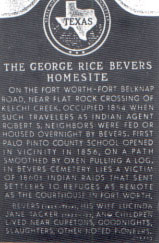An Arrow in the Water Bucket

About 1864, Houston Bevers, Allen, Jack and Ben Caruthers, and,
perhaps, one or two additional cowboys were batching on Keechi,
about three miles northeast of the present town of Graford, and
about two hundred yards northeast of the Huse Bevers ranch-house,
which still stands. During the dark hours of night, a barking
dog seemed to be considerably alarmed. So Allen Caruthers, who
was awakened by the noise, stepped out on the porch to ascertain,
if possible, what was causing the disturbance. Nothing could be
seen, so Allen rubbed his sleepy eyes and returned to bed. But
next morning when daylight came, some of the boys discovered an
arrow sticking in the wooden water bucket, which sat on a shelf
very near the door. An abundance of Indian signs were also discovered.
No doubt, when Allen Caruthers started back through the door,
an Indian missed his mark only by a narrow margin.
These ranch quarters belonged to Geo. Bevers at the
time. But the premises were deeded to Houston Bevers, his son, who
erected the Stone ranch-house that still stands near the Bever's
Graveyard.
Note: Author personally interviewed: Mrs. H.G. Taylor,
sister of Houston Bevers, and Mrs. Huse Bevers, both of whom were
living in Palo Pinto County at the time, and often heard their brother
and husband and the Caruthers boys relate the story.
George R. Bevers Shoots a Indian
It was about the year 1866 that Geo. R. Bevers,
one of the first settlers of Palo Pinto County, discovered an
Indian attempting to break open the locked door of a smokehouse
made of logs, which stood about thirty feet behind his dwelling.
Mr. Bevers lived near the old Flat Rock Crossing of Big Keechi,
about three miles east of the present town of Graford. He took
deliberate aim at the Indian, and when the flash of his gun echoed
against the silent walls of night, and alone the luxurious Keechi
bottoms, the Indian, who may have been wounded, vanished like
a dream.
Note: Author personally interviewed: Mrs. H.G.
Taylor, who at this time, was a grown and unmarried daughter of
Mr. Bevers.
Bevers Shoots to Alarm Savages
During 1868, he lived near where the Bever's home now stands,
about three miles east of the present town of Graford. During
the dark hours of night, the Indians, who were concealed under
the live oak trees near the well, southwest of the house, were
blating like a distressed calf that had been caught by wolves,
no doubt, for the purpose of decoying someone out, and to add
another scalp to their list of trophies. But "Grandpa"
Bevers was too wise for them. He took his gun, slipped out on
the porch, and shot in the direction of the noise. When he did,
the Indians instantly fired at the blaze of his gun. So "Grandpa"
decided he did not care to kill any more Indians just at that
time, and returned to the inside of his dwelling.
Note: Author interviewed Mrs. H.G. Taylor, a daughter
of G.R. Bevers, and Mrs. Huse Bevers, a daughter-in-law.
The above stories are from the book, The West Texas
Frontier, by Joseph Carroll McConnell.
|